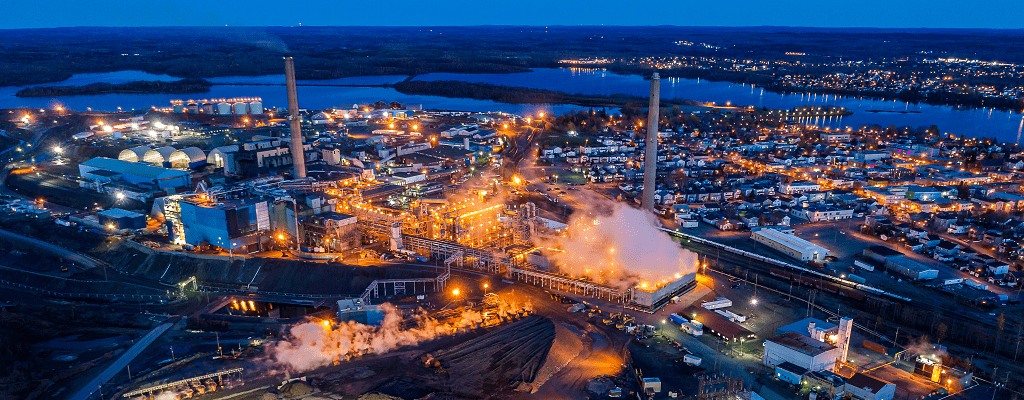Staff Writer | August 22, 2022

Horne is the only operating copper smelter in Canada.
Credit: Glencore Canada.
Glencore plans to invest more than C$500 million ($383m) in its Horne smelter located in Rouyn-Noranda, Quebec, with the aim of improving air quality to reduce its arsenic emissions to 15 ng/m3 within the next five years.

“This transformative project shows that our number one priority is to ensure our teams’ safety et security, as well as that of our neighbouring communities,” said Claude Bélanger, COO of Glencore’s North American copper assets.
“The investments we plan will make the Horne smelter one of the world’s lowest-emitting copper smelters. Myself and the team are fully committed to the future success of the Horne and the ongoing efforts to reduce emissions to ensure a performance that all stakeholders can trust and be proud of,” he added.
According to Glencore, this investment will comprise three pillars, the first being modernization of the smelter’s installations through the construction of cutting-edge technology. This transformation, named AERIS, includes the following projects: The complete reengineering of copper transformation processes (PHENIX);
The addition of a high-capacity air cleaning system (R3);
The construction of a new energy-efficient casting wheel (ECCO);
The finalizing of a larger transition zone between the smelter and the Notre-Dame district.
The second pillar involves transitional improvements to existing capture systems. They will be carried out on seven capture systems this year to accelerate emissions reduction until the new plant section is in operation in the summer of 2027.
The third and final pillar will be optimization of the facilities around the plan to maximally reduce emissions, even once AERIS is in operation. This includes an upgrade of the nine existing dust collectors.
“We are continuing the work initiated over the past 20 years, when our ambient arsenic emissions had been reduced by about 90% since 2000,” Bélanger continued. “Our plan is ambitious and marks the beginning of a new phase for the Horne smelter. We will continue to pro-actively engage with the government, public health authorities and community and other key stakeholders on our plan.”
“The smelter has been a proud part of the Canadian and Quebec mining industry for almost 100 years. Our investment will help ensure the Horne is fit for the future and can continue to support the province’s climate ambitions through its role as North America’s leading e-scrap recycler,” Bélanger concluded.
Earlier this month, Quebec’s public health director Luc Boileau called out the company for the amount of arsenic being emitted from its copper smelter, stating that the situation “is not acceptable.” According to Boileau, the plant is currently emitting 55 times the standard safe level of the toxic material, and it must be brought down to 15 nanograms per cubic metre of air on site.
The Horne smelter is the only copper smelter still operating in Canada.
Glencore plans to invest more than C$500 million ($383m) in its Horne smelter located in Rouyn-Noranda, Quebec, with the aim of improving air quality to reduce its arsenic emissions to 15 ng/m3 within the next five years.

“This transformative project shows that our number one priority is to ensure our teams’ safety et security, as well as that of our neighbouring communities,” said Claude Bélanger, COO of Glencore’s North American copper assets.
“The investments we plan will make the Horne smelter one of the world’s lowest-emitting copper smelters. Myself and the team are fully committed to the future success of the Horne and the ongoing efforts to reduce emissions to ensure a performance that all stakeholders can trust and be proud of,” he added.
According to Glencore, this investment will comprise three pillars, the first being modernization of the smelter’s installations through the construction of cutting-edge technology. This transformation, named AERIS, includes the following projects: The complete reengineering of copper transformation processes (PHENIX);
The addition of a high-capacity air cleaning system (R3);
The construction of a new energy-efficient casting wheel (ECCO);
The finalizing of a larger transition zone between the smelter and the Notre-Dame district.
The second pillar involves transitional improvements to existing capture systems. They will be carried out on seven capture systems this year to accelerate emissions reduction until the new plant section is in operation in the summer of 2027.
The third and final pillar will be optimization of the facilities around the plan to maximally reduce emissions, even once AERIS is in operation. This includes an upgrade of the nine existing dust collectors.
“We are continuing the work initiated over the past 20 years, when our ambient arsenic emissions had been reduced by about 90% since 2000,” Bélanger continued. “Our plan is ambitious and marks the beginning of a new phase for the Horne smelter. We will continue to pro-actively engage with the government, public health authorities and community and other key stakeholders on our plan.”
“The smelter has been a proud part of the Canadian and Quebec mining industry for almost 100 years. Our investment will help ensure the Horne is fit for the future and can continue to support the province’s climate ambitions through its role as North America’s leading e-scrap recycler,” Bélanger concluded.
Earlier this month, Quebec’s public health director Luc Boileau called out the company for the amount of arsenic being emitted from its copper smelter, stating that the situation “is not acceptable.” According to Boileau, the plant is currently emitting 55 times the standard safe level of the toxic material, and it must be brought down to 15 nanograms per cubic metre of air on site.
The Horne smelter is the only copper smelter still operating in Canada.
No comments:
Post a Comment